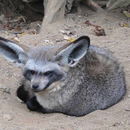en
names in breadcrumbs


Otocyon megalotis is the only species in the genus Otocyon.
Perception Channels: tactile ; chemical
CITES: no special status
IUCN Red List of Threatened Species: least concern
There is no apparent commercial use of bat-eared foxes, but they are hunted in Botswana for their pelts by indigenous people.
Their diet primarily consists of insects and other arthropods, and occasionally small rodents, lizards, the eggs and chicks of birds, and plant matter. The Harvester termite (Hodotermes) and dung beetles (Scarabidae) can make up 80 percent of the fox's diet (Macdonald, 1984). According to Delany and Happold (1979), bat-eared foxes obtain much of their water from the body fluids of these insects. The termites often feed on grass above ground, where they are then eaten by the foxes. Because large herbivores such as wildebeest, zebra and buffalo also feed on this grass, bat-eared foxes are usually found near large herds of these hoofed animals. Furthermore, bat-eared foxes are also associated with these mammals since they eat the dung beetles that feed on and lay eggs in the ungulate's feces. The foxes use their large ears to listen for beetle larvae gnawing their way out of the dung balls (Macdonald, 1984). Bat-eared foxes usually forage alone. However, where insect prey is abundant, bat-eared foxes may occur in very high densities. They can actually harvest more termites by foraging in a group than if they hunted separately over the same ground at the same time (Estes, 1991).
Animal Foods: birds; mammals; reptiles; eggs; insects; terrestrial non-insect arthropods
Primary Diet: carnivore (Insectivore )
Two populations are known, one from Ethiopia and southern Sudan to Tanzania; the other from southern Angola and Rhodesia to South Africa.
Biogeographic Regions: ethiopian (Native )
Bat-eared foxes are found in arid grasslands and savannas, preferring areas where the grass is short. They are capable diggers and live in dens that are dug by the foxes themselves or those left by other animals such as aardvarks. Dens have multiple entrances and chambers and several meters of tunnels. A family may have several dens in its home range.
Habitat Regions: terrestrial
One captive individual lived for 13 years and 9 months.
Range lifespan
Status: captivity: 14 (high) years.
Average lifespan
Status: captivity: 13.8 years.
Average lifespan
Status: captivity: 6.0 years.
The bat-eared fox's name comes from its enormous ears, which are 114 to 135 mm long. The body is generally yellow-brown; the throat and underparts are pale; the outsides of the ears, raccoon-like "face-mask," lower legs, feet, and tail tip are black. Besides the large ears, the bat-eared fox is set apart from other foxes by its unique dentition. It has more teeth than any other heterodont placental mammal with a total between 46 and 50 (Nowak, 1983). Whereas in all other canids there are no more than two upper and three lower molars, the bat-eared fox has at least three upper and four lower molars. On the lower jaw, a large step-like protrusion anchors the large digastric muscle that is used for rapid chewing of insects. The legs are relatively short.
Range mass: 3 to 5.3 kg.
Range length: 460 to 660 mm.
Other Physical Features: endothermic ; bilateral symmetry
To escape from predators, the bat-eared fox relies on speed and its incredible dodging ability. It can effectively reverse direction at a flat run without losing speed (Estes, 1991).
Bat-eared foxes are susceptible to predators down to the size of jackals and eagles. Diurnal birds of prey generally represent the greatest threat for young bat-eared foxes (Estes, 1991).
Bat eared foxes are usually monogamous; a few observations have suggested that sometimes there may be two females with one male, and one record exists of communal nursing (Macdonald, 1984).
Mating System: monogamous
Bat-eared foxes breed annually, in self-dug dens. Pups' eyes open at 9 days and they emerge from the den at 17 days. Newborns are sparsely covered with gray underfur and change to adult color by 4-5 weeks. Offspring are suckled for 15 weeks before beginning to forage with their parents. Pups are full grown by 5 or 6 months.After reaching maturity, most disperse at the breeding season. Some young females may stay with their natal group and breed. Males participate in guarding, grooming, and playing with the young as much as or even more than the mother. Mating behavior has not been described in the wild, but in a zoo, a pair mated 10 times a day for a week (Estes, 1991). The female showed no estrous swelling. The male followed the female intently, licking her vulva and periodically mounted. After intromission, the pair remained tied, as in many canids (Estes, 1991).
Breeding season: September to November
Range number of offspring: 2 to 6.
Average number of offspring: 3.2.
Range gestation period: 60 to 70 days.
Range weaning age: 30 (low) days.
Range age at sexual or reproductive maturity (female): 8 to 9 months.
Range age at sexual or reproductive maturity (male): 8 to 9 months.
Key Reproductive Features: iteroparous ; seasonal breeding ; gonochoric/gonochoristic/dioecious (sexes separate); sexual ; viviparous
Average birth mass: 122 g.
Average number of offspring: 4.
Parental Investment: altricial ; extended period of juvenile learning